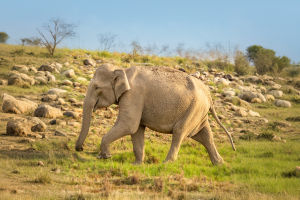Hey Lykkers, have you ever stood in front of an elephant and felt that mix of awe and calm? These creatures aren't just the largest land animals alive—they’re also incredibly smart, emotional, and deeply connected to their families.
Today, we’re diving into their world to learn why elephants continue to amaze us, and why we should care more about them.
Where Do Elephants Live?
We usually find elephants across different parts of Africa and Asia. The African elephant family includes two types: the African savanna elephant, which is larger and lives in grassy open spaces, and the African forest elephant, which is smaller and lives in dense rainforests. On the other side, there’s the Asian elephant, mostly found in South and Southeast Asia—places like India, Thailand, and parts of China’s southwest.
Each type has adapted to its unique environment. African elephants tend to have larger ears that help cool them down in hot weather, while Asian elephants have smaller, rounded ears and are often used in traditional festivals or local forestry work.
The Elephant's Signature Look
Elephants have thick, wrinkled skin and very little hair. But the most iconic feature? Their trunk! It’s actually a fusion of the nose and upper lip, forming a powerful, flexible tool. We’ve seen elephants use their trunks to eat, drink, greet each other, and even paint. And those long white tusks? They’re upper teeth that keep growing throughout an elephant’s life, used to dig, lift objects, or defend themselves if needed.
Their mouths are equipped with three premolars and three molars on each side. They don’t all come in at once—new ones grow in only after the old ones wear down. Here’s the incredible part: once the sixth and final set of molars wears out (usually around 60 years old), elephants struggle to chew food and might even die from malnutrition—unless we intervene and provide softened food.
What Do Elephants Eat?
These big eaters consume mostly plant-based food—leaves, grass, bark, and fruits. They need a lot of fiber to keep going, sometimes spending 16 to 18 hours a day just munching. That’s right—nearly their whole day is dedicated to finding and eating food! But they don't eat randomly. They know which plants are more nutritious and even use tools like tree branches to shake down fruits.
How Smart Are Elephants?
We’ve all heard people say elephants never forget. And it’s not just a saying. Studies show they have strong memories, can recognize themselves in mirrors, and show signs of empathy, mourning, and even cooperation. They remember old friends—even humans—after many years, and they grieve lost members of their herd. Their brains are among the largest in the animal kingdom, and their emotional intelligence is incredibly high.
Why Should We Protect Them?
Unfortunately, elephants face many dangers, especially from habitat loss and illegal hunting for ivory. Forest clearing, shrinking water sources, and human expansion all threaten their homes. That’s why it’s important for us to support conservation efforts—whether by spreading awareness, supporting elephant-friendly tourism, or donating to wildlife organizations.
Fun Tips for Spotting Elephants
If we ever want to see elephants in the wild, national parks like Kenya’s Amboseli or India’s Kaziranga are great choices. The best time? Early mornings or late afternoons when they’re more active. If we visit sanctuaries, it’s good to check that they treat elephants ethically—no riding or forced tricks, just protection and care.
Let’s Cherish Them Together
Lykkers, elephants are more than just massive animals roaming across forests and plains. They’re intelligent, emotional beings with stories, memories, and connections that mirror our own. The more we learn about them, the more we realize how important it is to protect them. Have you ever seen an elephant up close? Share your story with us—we’d love to hear it!
Elephants: Nature's Most Incredible Creatures
Video by Species Under Siege

